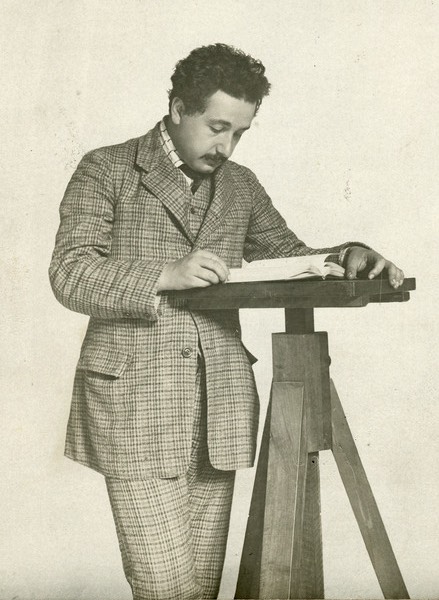

The Papers of Einstein's 1905 Annus Mirabilis
This is Einstein's doctoral dissertation, submitted after much delay to the University of Zurich. In it he uses available physical data on the diffusion of sugar in solution and the effect of dissolved sugar on the solution's viscosity to determine the size of sugar molecules and Avogadro's number. The analysis makes the kinetic theory of heat more definite, in so far as it provides a measure of the real size of molecules, so that they cannot be dismissed as easily as useful fictions. It is the least impressive of Einstein's work of 1905 although, curiously, the most cited."On the motion of small particles suspended in liquids at rest required by the molecular-kinetic theory of heat." (Brownian motion paper) (May 1905; received 11 May 1905)
In this paper Einstein reports that the kinetic theory of heat predicts that small particles suspended in water must execute a random motion visible under the microscope. He suspects this motion is Brownian motion but has insufficient data to affirm it. The prediction is a powerful test of the truth of the kinetic theory of heat. A failure to observe the effect would refute the theory. If it is seen and measured, it provides a way to estimate Avogadro's number. The domain in which the effect is observed is one in which the second law of thermodynamics no longer holds, a disturbing result for the energeticists of the time."On the electrodynamics of moving bodies" (special relativity) (June 1905; received 30 June 1905)
Einstein develops the special theory of relativity in this paper. His concern, as he makes clear in the introduction, is that then current electrodynamics harbors a state of rest, the ether state of rest, and the theory gives very different accounts of electrodynamic processes at rest or moving in the ether. But experiments in electrodynamics and optic have provided no way to determine which is the ether state of rest of all inertial state of motion. Einstein shows that Maxwell-Lorentz electrodynamics has in fact always obeyed a principle of relativity of inertial motion. We just failed to notice it since we tacitly thought that space and time had Newtonian properties, not those of special relativity."Does the inertia of a body depend on its energy content?" (E=mc2) (September 1905; received 27 September 1905) Annalen der Physik, 18(1905), pp. 639-41.
Written as a brief follow-up to the special relativity paper, this short note derives the inertial of energy: all energy E also has an inertia E/c2."On a heuristic viewpoint concerning the production and transformation of light." (light quantum/photoelectric effect paper) (17 March 1905)
While the victory in the 19th century of the electromagnetic wave theory of light over Newton's corpuscle view is undeniable, Einstein shows that its success is incomplete. The theory gives incorrect results for the analysis of heat radiation. He looks at the thermodynamic properties of high frequency heat radiation and finds that this radiation behaves just like a collection of many spatially localized units ("quanta") of energy of magnitude hf (h=Planck's constant, f=frequency). He proceeds to show how this quantum view of light makes sense of several experiments in electrodynamics and optics, the best know being the photoelectric effect. He then described the paper as "revolutionary."
Reading
John Stachel, "Introduction" to Einstein's Miraculous Year: 5 Five Papers That Changed the Face of Physics.
The Collected Papers of Albert Einstein: Volume 2: The Swiss Years: Writings, 1900-1909 (English translation supplement)
See Documents 14, 15, 16, 23 and 24. These are the English translations of the five papers above. Look at each and skim the first pages of each. Then read further in so far as your interest and expertise allows.
Or, if you prefer, see the original German in The Collected Papers of Albert Einstein: Volume 2: The Swiss Years: Writings, 1900-1909
Supplementary Reading
Here are some possibilities. Look at these according to your interest.
John D. Norton, "Einstein's Special Theory of Relativity and the Problems in the Electrodynamics of Moving Bodies that Led him to it." pp. 72-102 in Cambridge Companion to Einstein, M. Janssen and C. Lehner, eds., Cambridge University Press.
John D. Norton, Einstein for Everyone.
See Chapters:
9. Einstein's Pathway to Special Relativity
39. Atoms and the Quanta
(and anything else that looks interesting)